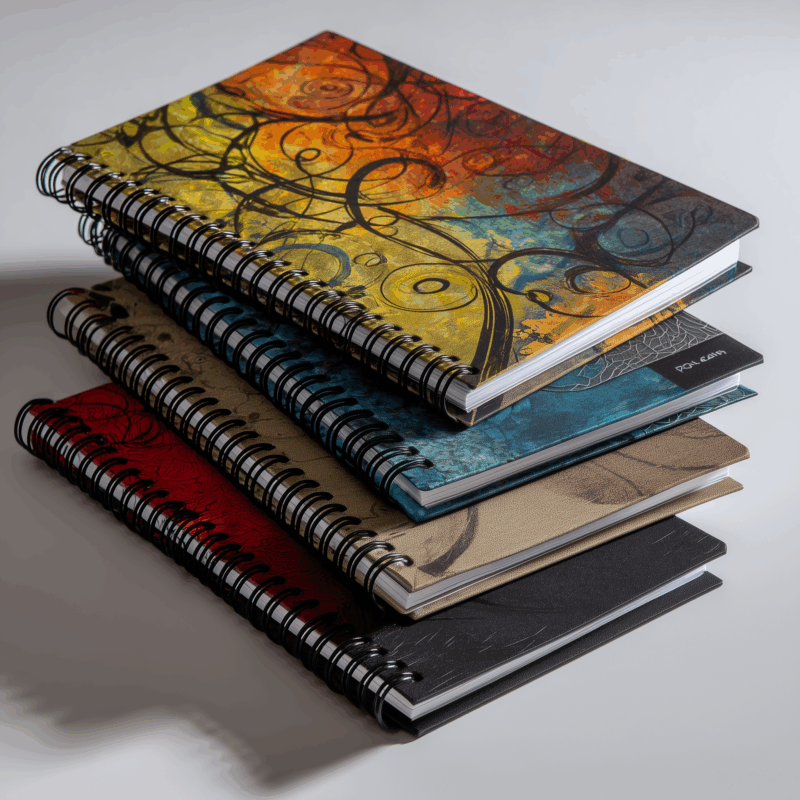Покупка спиральные блокноты оптом Может показаться, что все просто — выберите поставщика, разместите заказ и ждите доставки. Но на самом деле этот процесс полон скрытых ловушек, которые могут стоить вам времени, денег и даже репутации у клиентов. Я видел, как это случалось не раз: слишком тонкая бумага, разваливающиеся переплеты, некрасивый брендинг или поставки, которые приходят с опозданием на несколько недель.
Если вы ищете товары для школ, офисов или розничной торговли, вам следует обращать внимание не только на цену. качество бумаги и типы спиральных катушек к индивидуальная печать, логистика доставки, и надежность поставщика, есть критические факторы, которые нужно учесть, прежде чем вы берете на себя обязательства по крупным заказам. Особенно при работе с зарубежными поставщиками ясность в общении и знание того, что нужно проверить перед покупкой, могут иметь решающее значение.
В этом руководстве я расскажу вам пять самых распространенных ошибок покупатели делают при размещении заказов на оптовые партии спиральных блокнотов — и показывают, как их избежать. Независимо от того, являетесь ли вы опытным оптовым покупателем или новичком в поиске поставщиков, эти советы помогут вам принимать более разумные и безопасные решения о покупке.
Давайте разберемся.

📊 Идея для инфографического резюме (для блога или скачивания):
Заголовок: «Избегайте этих 5 ошибок при заказе большого количества спиральных блокнотов»
| ❌ Ошибка | ✅ Что делать |
|---|---|
| Плохое качество бумаги | Всегда проверяйте GSM и запрашивайте образцы |
| Слабое связывание | Выбирайте прочные, плавно вращающиеся катушки |
| Плохая настройка | Используйте дизайн высокого разрешения и утверждайте макеты |
| Задержки доставки | Планируйте за 4–6 недель, отслеживайте поставки |
| Ненадежный поставщик | Запросите сертификаты и историю заказов |

❌ Ошибка 1: Игнорирование стандартов качества бумаги
Многие покупатели слишком сосредоточены на цене и упускают из виду саму бумагу. Толщина (измеряется в GSM), текстура и цвет бумаги имеют решающее значение, особенно при продаже школам, офисам или университетам, которым требуются гладкие поверхности для письма и минимальное просачивание чернил. Тонкая или грубая бумага может хорошо выглядеть на фотографиях, но может привести к жалобам клиентов и возвратам.
Что делать вместо этого:
Запросите образцы бумаги перед размещением большого заказа. Спросите о таких характеристиках, как GSM, яркость и подходит ли для ручек, карандашей или маркеров. Всегда сопоставляйте качество бумаги с ожиданиями ваших целевых клиентов.
❌ Ошибка 2: Игнорирование материалов для спирального переплета
Не все спирали одинаковы. Пластиковые спирали низкого качества могут деформироваться или сломаться во время транспортировки, а тонкие металлические спирали могут зацепиться или потерять форму при частом использовании. Прочность и удобство переплета могут напрямую влиять на то, насколько профессиональным выглядит блокнот.
Что делать вместо этого:
Выбирайте проволочные или прочные металлические катушечные переплеты для долгосрочного использования. Если вам нужно экономичное решение, попросите поставщика объяснить разницу в вариантах материала катушки (например, одноконтурная и двухконтурная проволока). Убедитесь, что переплет выровнен на машине, чтобы избежать выпадения страниц.
❌ Ошибка 3: пропуск проверки качества настройки
Многие покупатели B2B хотят иметь фирменные или напечатанные на заказ спиральные блокноты. Но некачественная печать, размытые логотипы или неровные дизайны могут навредить вашему бренду. Непоследовательные цвета или низкое разрешение изображения могут превратить премиальный продукт в распродажный товар.
Что делать вместо этого:
Всегда запрашивайте предварительные образцы вместе с вашим произведением искусства. Тесно сотрудничайте с командой дизайнеров поставщика, чтобы обеспечить соответствие цветовым кодам CMYK или Pantone. Используйте файлы с высоким разрешением (300 точек на дюйм или выше) и утверждайте окончательный макет перед массовым производством.
❌ Ошибка 4: Недооценка сроков выполнения заказа и проблем с доставкой
Оптовые заказы обычно имеют более длительные циклы производства. Если вы покупаете за рубежом (особенно в пиковые сезоны), вы рискуете задержками из-за таможни, местных праздников или перегруженности порта. Многие покупатели планируют на основе предполагаемой доставки, а не фактической готовности к отправке.
Что делать вместо этого:
Планируйте как минимум за 4–6 недель. Подтвердите не только сроки производства, но и способ доставки (морем или воздухом), и запросите номера отслеживания. Работайте с поставщиками, которые предлагают обновления логистики в режиме реального времени, или сотрудничайте с надежными экспедиторами.
❌ Ошибка 5: Непроверка послужного списка поставщика
Некоторые поставщики выглядят профессионально в Интернете, но у них может не быть опыта, сертификатов или возможностей для выполнения крупных или индивидуальных заказов. Не проведя надлежащего исследования, вы рискуете работать с посредниками, а не с реальными производителями.
Что делать вместо этого:
Проверьте, владеет ли поставщик своей фабрикой. Попросите отзывы прошлых клиентов, сертификаты продукции (ISO, FSC) и образцы из предыдущих заказов. Используйте торговые платформы, такие как Alibaba, Made-in-China или даже LinkedIn, чтобы подтвердить их надежность и историю массового производства ноутбуков.
✅ Контрольный список для заказа большого количества спиральных блокнотов
📄 1. Качество бумаги
Подтвердите GSM (рекомендуется: 70–100 GSM для хорошего письма)
Запросить тест на совместимость текстуры бумаги и чернил
Запросите у поставщика реальные образцы письма.
🔁 2. Спиральное переплётное соединение
Выбирайте качественный металл (двухвитковая проволока) или толстый пластик.
Избегайте неплотно намотанной или неровно выровненной катушки.
Проверьте плавность перелистывания страниц.
🎨 3. Индивидуальная печать
Предоставьте логотип/иллюстрацию высокого разрешения (300 точек на дюйм+)
Подтвердите точность цветопередачи CMYK или Pantone
Утвердить физический или цифровой предсерийный образец
🚚 4. Доставка и сроки выполнения заказа
Подтвердите сроки производства и доставки (добавьте буфер)
Спросите о международных праздниках или перебоях в доставке
Отслеживайте обновления в режиме реального времени или работайте с экспедитором
🏭 5. Проверка поставщика
Спросите, владеют ли они производственным предприятием.
Запросить сертификаты (например, FSC, ISO)
Проверьте прошлый опыт оптовых заказов и отзывы

🧾 Резюме
Покупка спиральные блокноты оптом не просто поиск самой низкой цены — это баланс между качеством, кастомизацией, доставкой и доверием. Избежание этих пяти распространенных ошибок поможет вам защитить свои инвестиции, удовлетворить конечных пользователей и построить надежную стратегию поставок на долгосрочную перспективу.
📌 Часто задаваемые вопросы (FAQ)
1. Какова оптимальная толщина бумаги (GSM) для спиральных блокнотов оптом?
Для большинства целей письма идеально подойдет 70–100 GSM. Более плотная бумага (90–100 GSM) предотвращает просачивание чернил и ощущается более качественной.
2. Как гарантировать, что спиральный переплет не порвется во время транспортировки?
Выбирайте металлические двухконтурные или высококачественные пластиковые рулоны и закажите защитную упаковку или термоусадочную пленку для транспортировки.
3. На что следует обращать внимание при выборе надежного поставщика блокнотов на спирали?
Проверьте их сертификаты (ISO, FSC), прошлый опыт экспорта, аудиты фабрик и попросите предоставить реальные книги образцов или отзывы клиентов.
4. Могу ли я персонализировать спиральные блокноты своим логотипом и дизайном?
Да. Большинство поставщиков предлагают индивидуальные обложки, брендинг и внутренние страницы. Убедитесь, что вы предоставляете файлы высокого разрешения и подтверждаете пробные оттиски.
5. Каков типичный минимальный объем заказа (MOQ) для оптовых заказов спиральных блокнотов?
Большинству поставщиков требуется минимальный объем заказа в размере 500–1000 единиц в зависимости от уровня кастомизации и размера.
6. Сколько времени обычно занимает производство и доставка?
Производство занимает 15–30 дней в зависимости от сложности. Доставка варьируется: 7–15 дней по воздуху, 20–40 дней по морю.
7. Какие размеры наиболее популярны при оптовых заказах блокнотов на спирали?
Форматы A5 (148 × 210 мм), B5 (176 × 250 мм) и A4 (210 × 297 мм) являются наиболее распространенными в школах и офисах.
8. Могу ли я получить образец перед размещением оптового заказа?
Да. Надежные поставщики отправят бесплатный или недорогой образец для проверки качества перед окончательным производством.
9. Каковы распространенные варианты персонализации спиральных блокнотов?
Материалы обложки (художественная бумага, крафт, полиуретан), количество страниц, тип линовки (линованная, сетка, точка), цветная печать и специальная отделка.
10. Как избежать скрытых расходов при заказе больших тиражей ноутбуков?
Запросите полную смету, включая доставку, налоги и дополнительные услуги. Уточните условия оплаты и получите все в письменном виде.
![]()
Заказ спиральных блокнотов оптом может быть разумным и экономически эффективным решением, если все сделано правильно. Избежав распространенных ошибок, таких как неясные спецификации, плохой контроль качества и несогласованные сроки, вы защитите свой бюджет и бренд. Всегда работайте с опытными поставщиками, задавайте правильные вопросы и проверяйте каждую деталь перед подписанием. Хорошо организованный оптовый заказ — это не просто получение блокнотов, это обеспечение долгосрочной надежности, постоянного качества и удовлетворенности клиентов. Готовы сделать следующий шаг? Совершайте оптовую покупку с уверенностью и превратите каждую страницу в успех бизнеса.





